

Kathy Freston: Shattering The Meat Myth: Humans Are Natural Vegetarians. Going through the comments of some of my recent posts, I noticed the frequently stated notion that eating meat was an essential step in human evolution.
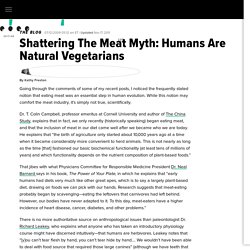
While this notion may comfort the meat industry, it’s simply not true, scientifically. Dr. T. Colin Campbell, professor emeritus at Cornell University and author of The China Study, explains that in fact, we only recently (historically speaking) began eating meat, and that the inclusion of meat in our diet came well after we became who we are today.
He explains that “the birth of agriculture only started about 10,000 years ago at a time when it became considerably more convenient to herd animals. That jibes with what Physicians Committee for Responsible Medicine President Dr. There is no more authoritative source on anthropological issues than paleontologist Dr. In fact, our hands are perfect for grabbing and picking fruits and vegetables. Were Humans Meant to Eat Meat? Humans are not made to eat meat. Prime: Yes, It's True: Humans Aren't Meant to Eat Meat. Ever since I first went vegetarian, I’ve heard comments like, “Eating animals is natural.
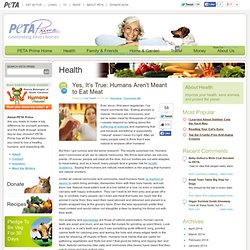
Humans are omnivores, and we’ve eaten meat for thousands of years.” I usually respond by talking about the suffering of animals and explaining that just because something is supposedly “natural” doesn’t mean it’s right. After all, many people used to think that it was natural to enslave other humans! But then I got curious and did some research. The results surprised me: Humans aren’t omnivores at all; we’re natural herbivores. How humans are not physically created to eat meat. How humans are not physically created to eat meat Although some historians and anthropologists say that man is historically omnivorous, our anatomical equipment teeth, jaws, and digestive system favors a fleshless diet.
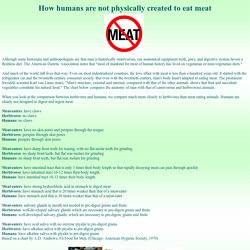
The American Dietetic Association notes that "most of mankind for most of human history has lived on vegetarian or near-vegetarian diets. " And much of the world still lives that way. Even on most industrialized countries, the love affair with meat is less than a hundred years old. It started with the refrigerator car and the twentieth-century consumer society. Humans are natural plant-eaters. According to the best evidence: our bodies by Michael Bluejay • June 2002 • Updated December 2015 A fair look at the evidence shows that humans are optimized for eating mostly or exclusively plant foods, according to the best evidence: our bodies.

We're most similar to other plant-eaters, and drastically different from carnivores and true omnivores.1,2,3 Those who insist that humans are omnivores, especially if their argument is based on canine teeth, would do well to look at what the evidence actually shows. We'll cover that below. I first wrote this article many years ago, but since then Milton Mills, M.D. published an excellent paper which covers the anatomy of eating, so let's skip right to my table-ized summary of his research: (90) J’ai vraiment été... La Face cachée de la viande-commentaire « Le blogue de Benoit Girouard. Je ne sais pas si nous étions nombreux dimanche soir à regarder l’émission la Face cachée de la viande, soit par curiosité ou par intérêt pour ce qui touche à notre assiette.

The Trouble With Beef. In a home kitchen, tenderizing a steak is typically done with a mallet adorned with points that pierce the surface of the meat.

In the beef industry, however, tenderization involves moving meat through machines with automated double-edged blades that shred the meat’s muscle fibers and connective tissues. Sometimes the industry also uses hollow needles to inject the meat with flavorings. The process helps the meat industry market tougher cuts, but it can hurt consumers.
“Although blading and injecting marinades into meat add value for the beef industry, that also can drive pathogens […] deeper into the meat,” reports The Star, where they often aren’t exposed to temperatures high enough to kill them. All of the big four meat packers—which together slaughter 87 percent of the country’s beef cattle—reported tenderizing their beef at some point during production. Photo: Adam Gault/Getty Images. La face horrible de la viande (VIDÉO) « Le blogue de Sophie Durocher. Sophie Durocher - 10 décembre 2012.

La face cachée de la viande. La face cachée de la viande - Bande annonce (fr) Canadians 'need to know' about mechanically tenderized meat - Canada. Canadians should be aware of the possible risks from a widely used mechanical process to tenderize steaks and roasts, a U.S. food safety advocate says.

Food safety concerns made headlines in late September after a recall of beef products processed at an XL Foods plant in Brooks, Alta. At least 16 people were sickened by meat contaminated with E. coli O157:H7. The Public Health Agency said evidence suggested some of the illness seemed to be caused by tenderized meat. Watch Marketplace's High Steaks episode Friday at 8 p.m. (8:30 p.m. in Newfoundland and Labrador). On Tuesday, the Canadian Food Inspection Agency issued a release saying that it had lifted the suspension on the licence of the XL plant in Brooks, Alta.
Porc. Antibiotiques. Viande et santé : attention danger. Manger de la viande, c’est mettre sa santé, et donc sa vie, en danger.
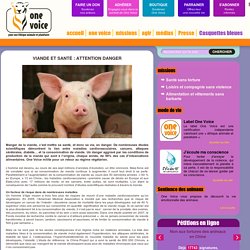
De nombreuses études scientifiques démontrent le lien entre maladies cardiovasculaires, cancers, attaques cérébrales, diabète… et la consommation de viande. Un danger aggravé par les conditions de production de la viande qui sont à l’origine, chaque année, de 90% des cas d’intoxications alimentaires. One Voice milite pour un retour au régime végétarien. L’homme est devenu, au cours de ses sept millions d’années d’évolution, un être omnivore.
Mais force est de constater que si sa consommation de viande continue à augmenter, il court tout droit à sa perte. Ground Turkey Study Finds More Than Half Of Samples Contaminated With Fecal Bacteria. More than half of ground turkey samples are contaminated with fecal bacteria, according to a new study from Consumer Reports.
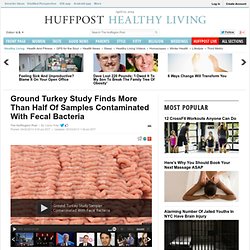
In addition, the magazine found that more than 90 percent of the ground turkey samples it tested contained at least one of the five bacteria the test was looking for -- salmonella, Staphylococcus aureus, E. coli, enterococcus and campylobacter (though no campylobacter was found). The test covered 257 retail samples from 21 states and 27 different brands, all purchased in retail stores. Sixty-nine percent of the ground turkey samples tested by Consumer Reports contained enterococcus, and 60 percent harbored E. coli -- both of which are associated with fecal contamination. Some of the bacteria found in the tested samples can cause food poisoning, as well as urinary, bloodstream and other infections. Industry groups were quick to attack the Consumer Reports findings. The FDA objected to the Environmental Working Group report, and warned of oversimplification.
DIRTY Little SECRET about MEAT. What government tests found in your meat. If you become ill from antibiotic-resistant bacteria, doctors have fewer drug options to treat you. Antibiotic-resistant bacteria found in raw meatA microbiologist notes the levels are lowMore than 31 million pounds of antibiotics are sold for animal use. Meat contaminated: US meat contaminated with staph bacteria. Meat in the U.S. may be widely contaminated with strains of drug-resistant bacteria, researchers reported Friday. Nearly half of all meat and poultry sampled in a new study contained drug-resistant strains of Staphylococcus aureus, the type of bacteria that most commonly causes staph infections.
Such infections can take many forms, from a minor rash to pneumonia or sepsis. But the findings are less about direct threats to humans than they are about the risks of using antibiotics in agriculture. Du boeuf contaminé par un médicament toxique. La phénylbutazone est un analgésique et un anti-inflammatoire utilisé pour traiter la boiterie chez le cheval, qui n'est pas homologué pour le boeuf au Canada. Ses résidus, qui peuvent mener à des troubles hépatiques, représentent «un risque élevé pour la santé humaine», selon l'Ordre des médecins vétérinaires du Québec. Le danger est tel que l'Agence canadienne d'inspection des aliments (ACIA) applique une politique de tolérance zéro quant à la présence de cet anti-inflammatoire dans les aliments.
Documentaire sur la consommation de viande, l’impact climatique et la santé (vidéo impressionnante) La Face cachée de la viande-commentaire « Le blogue de Benoit Girouard. U.S. Meats Tainted With Bacteria. Staph bacteria contaminated nearly half of U.S. meat samples in a recent analysis, with 96 percent of bacteria showing resistance to at least one type of drug. The most common bacteria found was Staphylococcus aureus, which showed genetic differences and varying levels of drug resistance based on the type of meat it was found in.
NEWS: Even Bacteria Get Lonely During the project, scientists studied 136 samples of beef, pork, turkey and chicken from 26 grocery stores in five U.S. cities. La face cachée de la viande - documentaire entier. Viande reconstituée , malbouffe. Et si on mangeait moins de viande? Meat and Cancer: The Carnivore's Conundrum. The media are abuzz with conflicting reports about the possible cancer risks of eating red meat, reinforcing already widespread confusion among consumers.